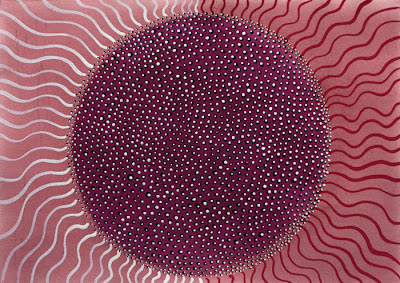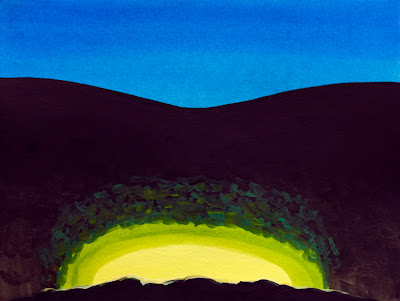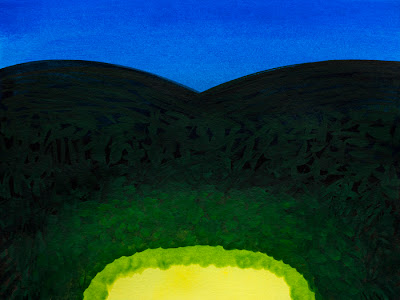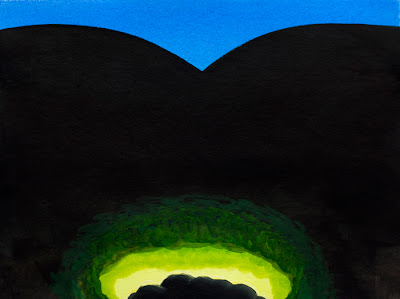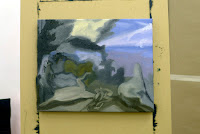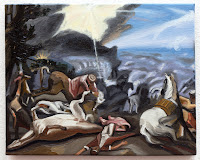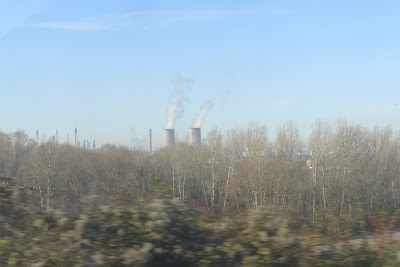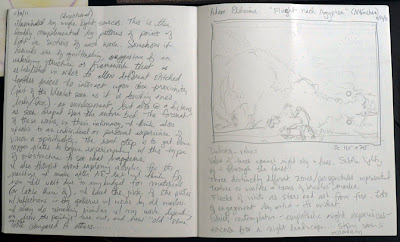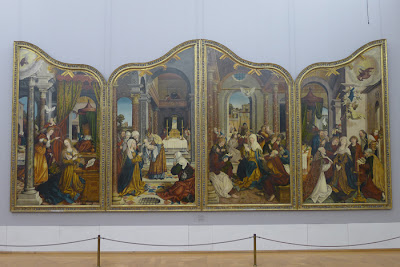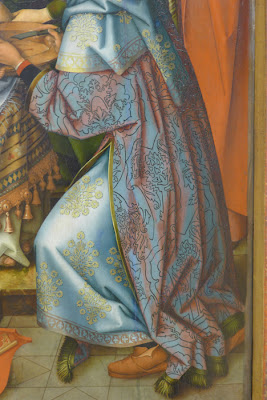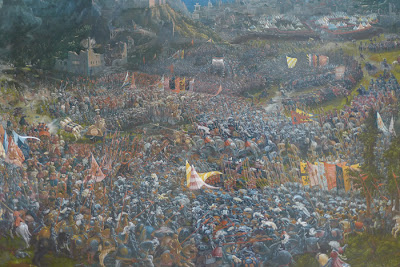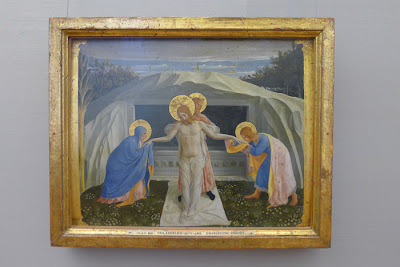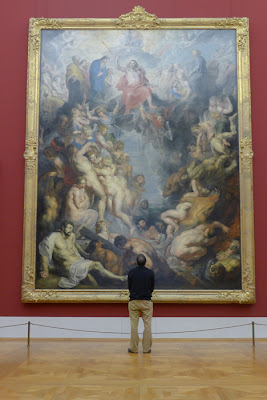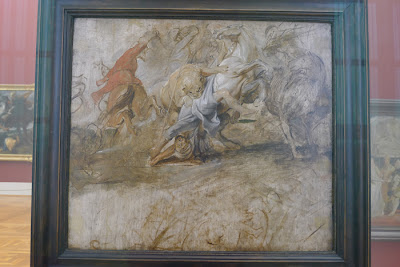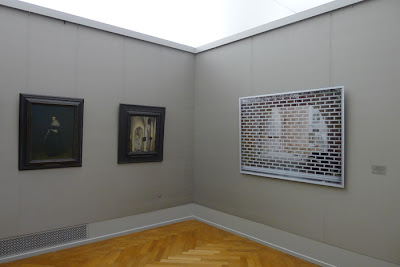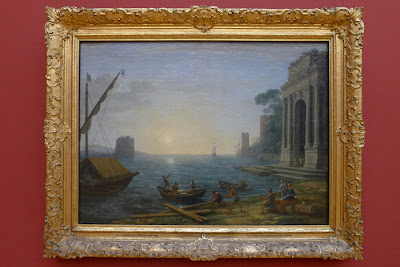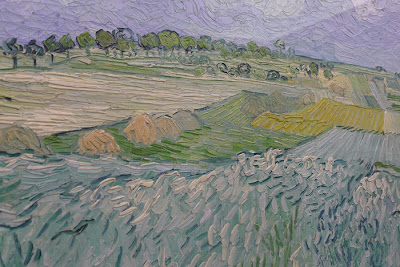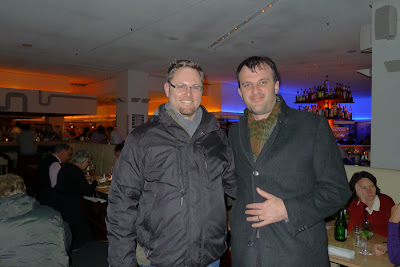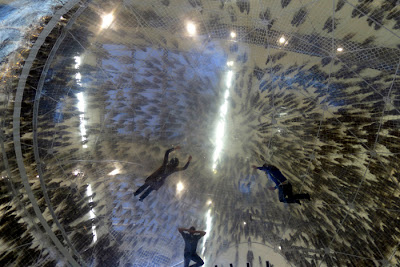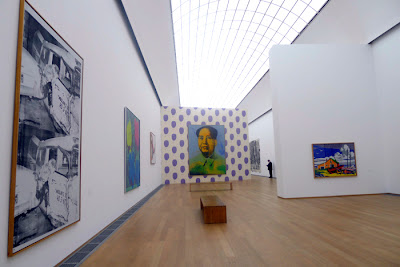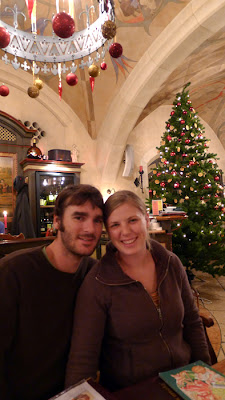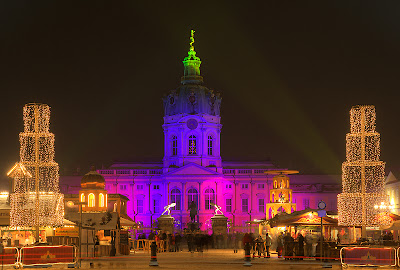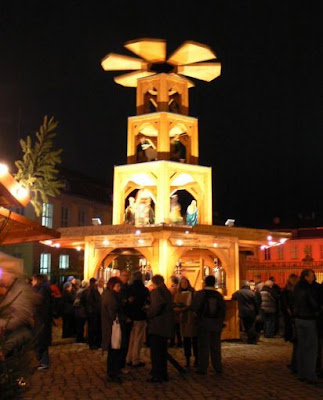I hope this finds you enjoying the festivities of welcoming 2012, the year of the Water Dragon! The following post recaps the past month, details some new works, art-related experiences, our visits to Munich, exhibitions in Berlin, and our enjoyment of the Weihnachtsmarkts while visiting with family and friends.
To begin with, my first open studios as an artist in residence at GlogauAIR took place on Dec. 16 & 17. I showed oil paintings as well as works on paper, and we had a lively turnout, especially on the opening day. Several Berlin Fulbrighters and new friends came by, and I met some interesting visitors at the event, which also featured the work of other artists in residence including performance, video, collage, photography, painting, sculpture and combinations thereof. Here is a selection of works I exhibited.
To see more, visit my updated website: http://www.caetlynnbooth.com/.
Winter Sonnenflecken, 8" x 12"
Alle sehen universum, 10" x 13"
Licht von unten 1, 10" x 13"
Licht von unten 2, 10" x 13"
Licht von unten 3, 10" x 13"
These images show the progression of After AE, The Conversion, after an Elsheimer titled "The Conversion of Saul."
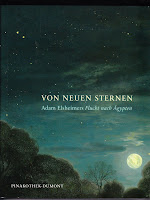 After a recent visit to Munich to view works by Elsheimer in person, especially the painting "Flight into Egypt" and to meet with Dr. Dekiert at the Alte Pinakothek, I received a copy of Von Neuen Sternen, the catalog that accompanied a recent exhibition centering on this very painting. It's written in German only, so I am excited about the challenge of translating to better understand contemporary discourse about this important work. I will write more about my meeting with Dr. Dekiert later in this post.
After a recent visit to Munich to view works by Elsheimer in person, especially the painting "Flight into Egypt" and to meet with Dr. Dekiert at the Alte Pinakothek, I received a copy of Von Neuen Sternen, the catalog that accompanied a recent exhibition centering on this very painting. It's written in German only, so I am excited about the challenge of translating to better understand contemporary discourse about this important work. I will write more about my meeting with Dr. Dekiert later in this post.  I have also recently acquired more reading material relating to Elsheimer including Lives of Adam Elsheimer featuring the translation of statements that other artists made about Elsheimer while he was alive or just after his death. A short but interesting read as a window into his life, although it's striking just how little was recorded in the writing of his contemporaries and peers, who expressed so much praise for his work.
I have also recently acquired more reading material relating to Elsheimer including Lives of Adam Elsheimer featuring the translation of statements that other artists made about Elsheimer while he was alive or just after his death. A short but interesting read as a window into his life, although it's striking just how little was recorded in the writing of his contemporaries and peers, who expressed so much praise for his work.
Lastly, because I enjoyed reading Camera Lucida by Barthes, I've also started reading Mythologies. More about my take on this book will come in my next post, but already the unusual position Barthes' strikes creates an interesting perspective for considering the definition and place of mythology, and the assumptions that come from taking this relationship for granted in the creation of meaning and how this becomes lived expression. Published in 1957, I'm interested to see where this inquiry leads, and how some of the ideas presented can be further understood through contemporary culture.
I also recently went to a lecture given by W.J.T. Mitchell at C/O Berlin ("Check Out Berlin"). The lecture accompanied the exhibition Bilder von Terror (Images of Terror), so as you can see below, there were several images of the attack on the World Trade Center as well as works that involve the brutality and violence of war. Again, a Thomas Hirshhorn work (not represented here), also spoke to the brutality of images when used irresponsibly as gornography, depicting the mutilated bodies from recent conflicts. His sloppy use of found images that he puts his name to without qualification is disappointing.
The lecture was interesting and political, especially because of the upcoming presidential election in the U.S., and because of the power and politics of images used for war. Food for thought.
Photo credit: Tyson Washburn
Besides Berlin, we've spent time in Munich recently. The train ride is always interesting.
Photo credit: Tyson Washburn
Sunset at the train station, waiting for our transfer.
Our trip in November was mostly "business." Of our three full days there, I spent two of them entirely at the Alte Pinakothek looking at Elsheimer's versions of the "The Flight into Egypt" and "The Burning of Troy," and meeting with Dr. Dekiert.
Here it is! So amazing to see in person.
I took several photos, made sketches and took notes, but have only included a couple here. This is a detail from "The Burning of Troy." In it's entirety, I especially think the use of multiple contrasting points of light in the composition to create space and form is very interesting.
My meeting with Dr. Dekiert was great, and he was very generous with his time in answering the questions I had. We discussed AE's work in the context of other art and artists of the period, and Dr. Dekiert's perspective as an art historian helped to fill in some important gaps. In his opinion, AE was very much of his moment, influenced by changes in the schools of scientific thought taking place in the early 17th century. AE ran in highly educated circles in Rome, and these new ways of thinking lead to new ways of seeing, evident in works such as "Flight into Egypt" with the Milky Way and several constellations represented in combination with religious narrative. We also talked about AE's unusual inventiveness, breaks with tradition, how he evoked mood, the materials and format he worked in, and the intimate scale and viewing practices of the time for these works--they were cabinet paintings put into thick frames, intended to taken out and held while being looked at.
For consistency in approach for this project, I have been making a sketch and taking detailed notes about the aspects of each painting that interests me most. It's been a very informative process to identify these kinds of attributes, and then invent my own process to make something similar happen in my painting. The page from my journal above is an example of this, about the painting "Landschaft mit badender Nymphe" located at the Gemäldegalerie here in Berlin.
There are several very large alter paintings with uniquely shaped panels.
This detail is from a large alter painting by Hans Holbein d. A.
Detail from Albrecht Altdorfer's amazing battle scene "The Battle of Issus/Alexander" 1529
Fra Angelico, 1440
The Rubens collection is the most impressive I've seen. This is "The Last Judgement." It's 6 meters high, and the scale of the museum was built specifically for this painting. It's been in the same gallery since the museum opened in the 1830s.
I really enjoyed seeing all the smaller painted sketches that Rubens made before the larger paintings were executed by his workshop.
In several of the smaller galleries on the second floor of the Alte Pinakothek, a contemporary photograph by the artist Sabine Hornig is displayed alongside paintings that are much older. I found it to be an intriguing and fitting curatorial break from the norm.
By Claude Lorraine, and artist who Elsheimer influenced
We also popped over to the Neue Pinakothek. Here are a few paintings/details from the collection:
Van Gogh detail
Van Gogh detail
Cezanne's first painting featuring Mont Sainte-Victoire
Thanks to Jeff, for his hospitality in Munich! We had an insider's welcome, and a great visit.
The scale of the galleries and quality of the exhibitions of some of the 20th century's most well-known figures is impressive:
Warhols galore!
And a room of Kiefers
The most surprising and fascinating exhibition was by an artist I wasn't aware of before. Several galleries were dedicated to Paul Laffoley's exhibition "Secret Universe II":
My brother and Emily during their visit! We've had a great time together for the holidays between activities in Munich and Berlin, cooking Christmas meals, going to Weihnachtsmarkts, and celebrating the New Years Berlin-style (loud, and all night long).
In closing, here are some images from the Weihnachtsmarkts--amazing light festivals focusing on food, drink, merriment and arts & crafts for gifts. The Charlottenburg Schloss, near our apartment, put on one of the best light shows in addition to creating an intimate festive environment:
Photo credit: Michael F. Gerlach
We especially appreciated the lights because the sun sets at 4:30pm this time of the year!
Photo credit: B. Sabrowski
Our favorite Glühwein station.
Until next time, Zum Vohl und Guten Rutsch! I toast to your good fortune in the New Year with honey-Mead! (from the Mittelaltermarkt).
XO Caetlynn
